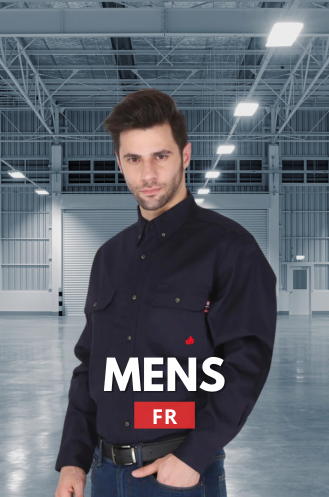For safety and compliance, flame-resistant (FR) clothing is essential in industries such as welding, oil and gas, and electrical work. FR Jeans have grown in popularity among the available options because they combine protection, style, and comfort. However, selecting the right pair for your specific workplace can be a challenge.
Knowing what you need and what options are available to you will help you make the best choice. This blog will help you choose the best FR Jeans for your sector.
Why is it crucial to select the appropriate FR Jeans?
Safety is the main reason people opt for fire retardant clothing, and picking the right jeans is essential because you can’t take any chances with your safety. Serious injuries can result from workplace incidents such as electrical hazards or fires.
Both employers and employees must select the right protective clothing, including FR Jeans. When you choose the right pair, you not only protect yourself from flames and heat but also stay comfortable since you’ll be wearing them all day.
By choosing FR Jeans that meet the standards of your place of employment, you can lessen the likelihood of work-related accidents and contribute to a safer working environment. Being in a safe environment can also help you be more productive.
While it’s crucial to wear FR clothing to work, it’s equally important to choose the right styles that suit your work conditions.
Key Points to Consider Before Buying FR Jeans
When it comes to choosing the right FR Jeans, several important factors should be on your checklist. The following are the key points to remember:
Understand Industry Requirements
Different industries have unique safety standards and regulations for FR clothing. It’s crucial to know the specific requirements for your field before making a purchase. For example, the oil and gas, electrical utilities, and manufacturing sectors may have different standards based on their specific risks.
Be Aware of Potential Risks
Understanding the risks present in your workplace will help you determine the level of protection you need. This knowledge is vital for selecting the right clothing.
Check the Materials Used
Examine the materials of the jeans you’re considering. Opt for options made from cotton, as it offers better breathability and comfort for extended wear.
Ensure a Good Fit and Comfort
If shopping in-store, try on the FR Jeans to ensure they fit well. Pay attention to size, length, material, and design to guarantee comfort. If shopping online, verify that the site offers an exchange and return policy in case the fit isn’t right.
Read Reviews Before Purchasing
Check customer reviews and testimonials to gain insight into the jeans' quality and safety. Feedback from previous buyers can provide valuable information about the product’s performance in real-world situations.
Choosing Fire-Retardant Clothing for Your Industry
Every industry has unique risks that workers may encounter during their shifts. For instance, the dangers in the oil and gas sector differ significantly from those in healthcare.
This suggests that different industries have different needs when it comes to flame-resistant clothing. For example, electrical workers might need jeans that meet specific safety standards, while welders may require extra protection from sparks.
Knowing these differences is important for choosing the right FR Jeans to keep you safe at work. You must understand the materials that will provide the best safety and protection for your particular work environment.
While some industries prioritize protecting against electrical hazards or arc flashes, others mandate FR Clothing to prevent flash fires. Here’s a quick guide on how to choose FR Clothing based on your industry:
Oil and Gas Industry: Flammable liquids and gases pose hazards to workers in this industry. When choosing FR apparel, look for options that protect against flash fires and associated hazards. Also, make sure to check for compliance with standards like NFPA 2112 and NFPA 2113.
Manufacturing Industry: The manufacturing sector often generates heat, sparks, or flames, increasing the risk of fire incidents. FR Clothing here should be durable and comfortable and adhere to relevant standards, such as NFPA 350 for safe movement during emergencies or NFPA 654 to prevent dust explosions.
Construction Industry: Construction workers regularly encounter flames and chemicals, as well as exposure to sunlight. When choosing FR Jeans, ensure they meet industry standards like 29 CFR 1926 Subpart E and NFPA 701 for optimal safety.
Final Words
Selecting the right FR Jeans is crucial for ensuring safety and comfort in high-risk work environments. Understanding the unique risks associated with your industry, evaluating the quality of the materials, and ensuring a proper fit will help you make an informed decision that will protect you from potential electrical and fire hazards.
We offer a large selection of compliant FR Jeans at Forge that are designed to satisfy various workplace requirements.
Don’t compromise on your safety explore our collection today and find the perfect pair to keep you protected on the job.
FAQs
Q.1 What does FR mean in jeans?
Ans. FR in jeans stands for "flame-resistant." It signifies that the cloth has been treated or made resistant to fire and flame spread.
Q.2 How fire-resistant are jeans?
Ans. Fire-resistant jeans can tolerate brief exposure to flames and heat but are not entirely fireproof. They provide additional protection to workers in dangerous areas.
Q.3 Are FR Jeans more durable?
Ans. FR jeans are often more durable than ordinary denim. Their specialty materials can withstand harder conditions, making them appropriate for industrial applications and increasing longevity.
Q.4 What is the FR rating?
Ans. The FR rating assesses a garment's capacity to prevent sparking and flame spread. It is determined by testing against particular safety requirements often stated in categories or levels.
Follow us on Facebook



